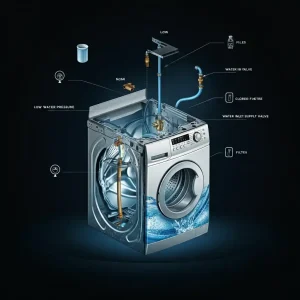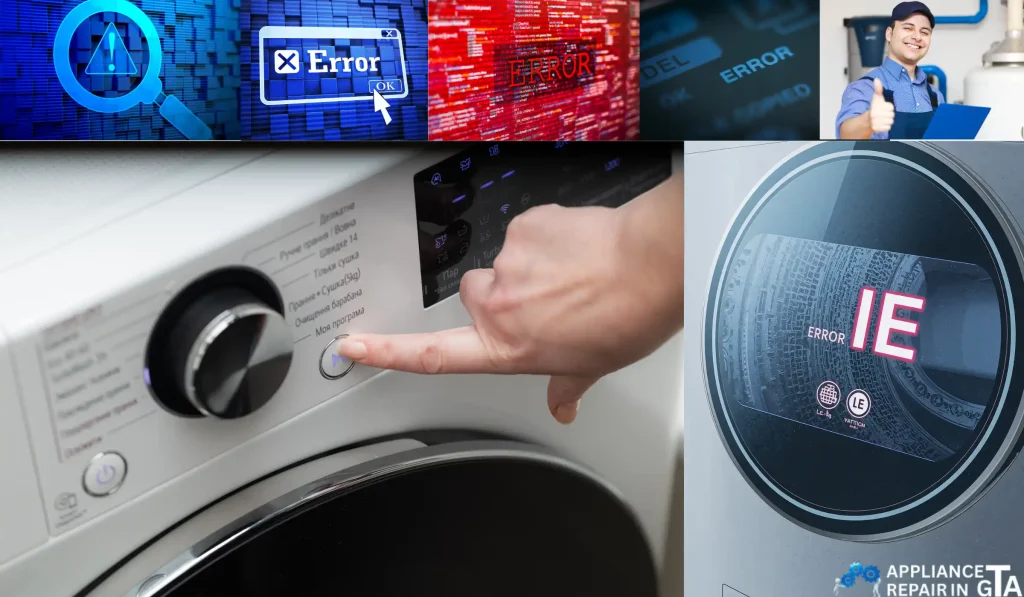It can be frustrating when a household chore is interrupted by an unexpected error code. If an LG washing machine displays the IE error, it signals a problem with the water supply. The “IE” stands for “Inlet Error,” meaning the appliance is not filling with water as quickly as it should, or at all. This guide will walk you through what this code means, the common causes, and how to troubleshoot the issue, from simple checks to more advanced diagnostics.
Quick Answer: The “IE” error on an LG washing machine means the washer isn’t filling with water fast enough. This is usually due to a water inlet system issue—commonly caused by low water pressure, clogged inlet filter screens, kinks in hoses, or a faulty water inlet valve.
What Does the IE Error Code Mean?
When your LG washing machine shows the IE error code, it’s telling you there is a water inlet error. The machine’s control system expects the tub to fill to a certain water level within a set amount of time. If it fails to reach that level, the cycle pauses and the IE error appears on the control panel. This is a protective measure to prevent the washer from running without sufficient water, which could damage the machine or your clothes. While it points to a water supply problem, the root cause can range from a simple kinked hose to a faulty electronic component.
Common Causes of the Water Inlet Error

Several issues can disrupt the water flow into your LG washer. Understanding these potential causes is the first step toward finding a solution.
- Low Water Pressure: The machine requires a minimum water pressure to fill correctly. If the pressure from your home’s water pipe is too low, the washer will fill too slowly, triggering the error.
- Blocked Water Supply Lines: Kinks in the water supply hoses or blockages within your home’s plumbing can restrict water flow.
- Clogged Inlet Filters: Small filter screens located where the hoses connect to the washer can become clogged with sediment, rust, or other debris over time.
- Faulty Water Inlet Valve: The valve itself, which opens and closes to let water in, can fail electronically or mechanically.
- Frozen Water Lines: In colder climates, water in the supply lines can freeze, completely blocking the flow.
How to Fix the IE Error: Step-by-Step Component Checks
Before calling for a repair service, there are several checks you can perform yourself. These steps address the most common culprits behind the IE error.
1. Inspect the Water Supply Hoses
Start with the most straightforward check. Look at the back of the LG washing machine and examine the water inlet hoses. Ensure they are not kinked, bent, or pinched, as this can severely limit water flow. Also, confirm that the water supply taps connected to the hoses are fully open. Sometimes, they can be accidentally turned off or only partially opened.
2. Clean the Inlet Filter Screens
If the hoses are fine, the next step is to check the water filters. These small screens are a common source of blockages.
- Turn Off the Water: Shut off the water supply at the taps connected to the washer.
- Disconnect the Hoses: Carefully unscrew the water supply hoses from the back of the machine. Have a towel ready to catch any residual water.
- Remove and Clean the Filters: Inside the connection ports on the washer, you will see the inlet filter screens. Gently pull them out with a pair of pliers. Clean them thoroughly under running water, using a soft brush to remove any sediment or buildup.
- Reassemble: Once clean, place the filters back into the ports and securely reconnect the water hoses. Turn the water supply back on and check for leaks.
3. Check for a Faulty Water Inlet Valve
The water inlet valve is an electronic component that controls the flow of water into the tub. If this part fails, the washer won’t fill. A faulty water inlet valve may make a buzzing noise without letting water through or may not activate at all. Testing the entire water inlet valve assembly often requires a multimeter to check for electrical continuity. If you suspect the valve is the problem but are not comfortable with electrical testing, it may be time to seek professional help.
Advanced Diagnostics for Persistent IE Errors
If the simple checks do not resolve the issue, the problem might lie with the machine’s internal control system or sensors.
Issues with the Water Level Sensor or Pressure Switch
The LG washer uses a water level sensor, also known as a pressure switch, to know how much water is in the tub. This sensor works by measuring air pressure in a tube that runs from the bottom of the tub to the switch. If the sensor is faulty, it might incorrectly report that the tub is full when it’s empty, or vice versa. A malfunctioning pressure switch can sometimes cause the IE error to appear even when the water supply is perfectly fine.
Problems with the Main Control Board
In rare cases, the IE error can be caused by a problem with the main control module or control board. This is the brain of the washing machine, and if it malfunctions, it can send incorrect signals or fail to properly interpret signals from sensors like the pressure switch. A faulty control system is usually the last thing to consider, as it’s the least common cause and the most expensive to fix. Diagnosing a faulty control panel or board is a complex task best left to a qualified technician from an LG service center.
When to Call a Professional Repair Service
If you have performed all the DIY checks and the IE error code keeps coming back, it is time to contact a professional for washer repair. A technician has the diagnostic tools, like a water pressure gauge, and the expertise to accurately identify the problem. Whether it’s a hidden blockage, a faulty water inlet valve assembly, or an issue with the control board, a certified repair service can fix it safely and correctly. Attempting complex electrical repairs yourself can be dangerous and may cause further damage to different washer models.
Having trouble fixing the IE error on your LG washing machine? Our certified technicians can help quickly and safely. Contact Appliance Repair in GTA for Service
By methodically checking your water supply, hoses, and filters, you can often solve the IE error on your LG washing machine without professional help.
Preventing Future IE Errors
- Clean inlet filter screens every 3–6 months to prevent blockages.
- Check water supply hoses regularly for kinks, leaks, or wear.
- Maintain consistent home water pressure between 20 and 120 psi for optimal washer performance.
- Use only approved LG washer hoses and genuine parts to reduce the risk of future inlet errors.
However, knowing when to call for assistance ensures your appliance gets the expert care it needs for more complex internal issues.
Frequently Asked Questions
- What does the IE error code mean on an LG washing machine?
It means the washer isn’t filling with water fast enough, usually due to issues in the water inlet system like low water pressure, clogged filters, or a faulty water inlet valve. - How do I fix the IE error on my LG washer?
Check for kinks or leaks in the water hoses, clean the inlet filter screens, and ensure your home water pressure is adequate. If the issue persists, inspect the water inlet valve or contact a repair service. - Can low water pressure cause the IE error?
Yes, insufficient water pressure can prevent the washer from filling properly, triggering the IE error code. - What is the role of the water inlet valve in an LG washer?
The water inlet valve controls the flow of water into the washer. If it’s faulty, the machine may not receive enough water, resulting in the IE error. - How often should I clean the inlet filter screens?
Clean the inlet filter screens every 3–6 months to ensure proper water flow and reduce blockage risk. - When should I call a professional for the IE error?
If basic troubleshooting steps don’t clear the code, or if there may be an electrical or control board issue, call an authorized LG service center or professional washer repair service. - Can the IE error be caused by a power outage?
Yes, sometimes a power outage or surge can cause a temporary IE error. Try resetting your washer and see if the error clears.
